Effective Ways to Remove Water from Your Ear
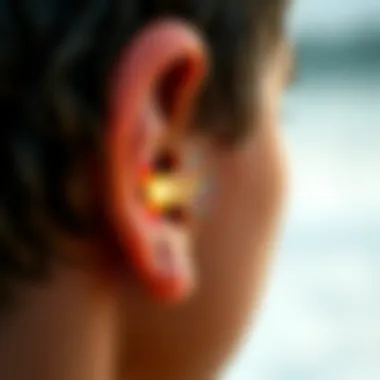
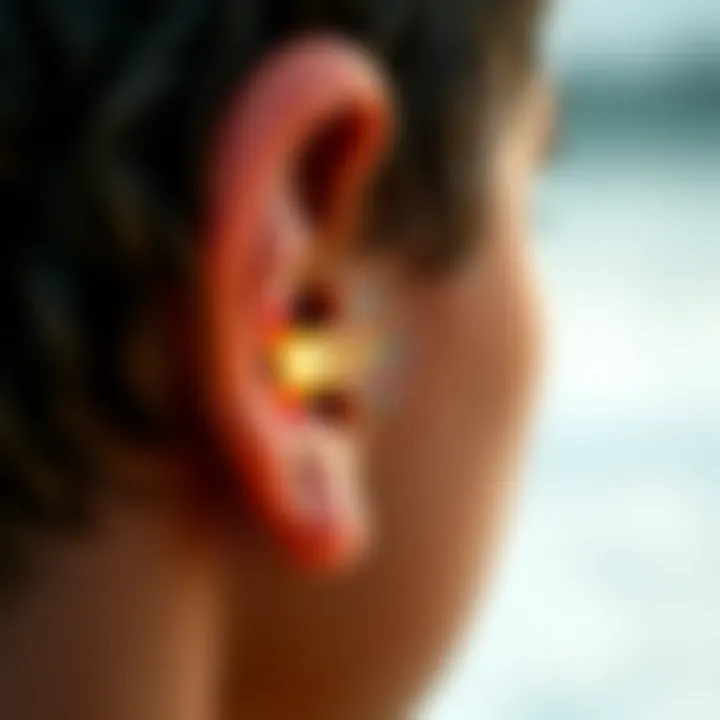
Intro
Water trapped in your ear can feel like an irritating itch that just won't go away. It can come from swimming, showering, or just a sudden wave splashing your face while surfing. The sensation can be uncomfortable and even worrisome, as it might lead to infections or other complications if not dealt with properly. Understanding how to manage this predicament can be quite beneficial. In this guide, we'll look at the common causes of water accumulation in the ear, reveal a series of practical techniques to eliminate it, and discuss prevention tips to keep discomfort at bay.
While some might think of this issue as merely a nuisance, it’s essential to recognize the implications it can have on one’s well-being. Constantly feeling fullness in your ear can lead to a lack of concentration, and one might even have a nagging desire to constantly clear the ear. Therefore, having a reliable toolkit of solutions on hand can make a significant difference.
In the following sections, we’ll dive into practical methods, highlight important preventative measures, and clarify when it might be wise to consult a healthcare professional for further assistance. Let’s equip you with the knowledge to address this common issue effectively.
Gear and Equipment
For outdoor enthusiasts, especially surfers and swimmers, having the right gear can significantly reduce the risk of water getting trapped in your ears. While one might not typically think of specialized equipment in relation to ear care, there are some handy items that can enhance your overall experience in the water.
Water-Resistant Ear Plugs
Investing in high-quality, water-resistant ear plugs can be a game changer. Brands like Mack's and Westone offer options that are comfortable and durable. They fit snugly in the ear and prevent water from entering while you enjoy your time in the water. A good pair can save you the trouble of dealing with that pesky water afterwards. They are especially essential for those who find themselves frequently submerged.
Swim Caps
Though typically seen as a swimmer's accessory, swim caps can help keep water out of your ears. They cover the ears well and can be particularly useful for long sessions in the pool or ocean. Look for a cap that fits snugly without causing discomfort. This is a small investment for a significant gain in comfort.
"Prevention is better than cure." Having the right gear can save much hassle in the long run.
Towels and Accessories
Always keep a towel on hand for quick drying after swimming or showering. A microfiber towel, for instance, absorbs water faster and is more compact, making it easier to carry around.
Drying Aids
Some users swear by using a hair dryer on the lowest setting at a safe distance, while others prefer a simple method like tilting the head and gently tugging on the earlobe to allow gravity to do its work. It’s good practice to find what suit you best.
Ultimately, the right combination of accessories tailored to your activities can reduce water-trapping incidents and keep your ears happy as you embrace your aquatic adventures.
Techniques for Getting Water Out
Now that you are equipped with some essential gear, let's delve into effective methods to release that stubborn water trapped in your ear. While some techniques may seem more effective than others, it's crucial to try what feels right for you and be patient.
Gravity Method
One of the simplest approaches is to use gravity. By tilting your head to the side and pulling on your earlobe, you may be able to let the trapped water flow out naturally. This method works best if you stay calm and relaxed, allowing gravity to take its course.
The Jaw Movement
Another straightforward tactic involves moving your jaw. Opening and closing your mouth, or yawning, can create pressure in the ear. This movement can help dislodge the water trapped inside. Just a few minutes of gentle jaw movement can often be enough to work the water free.
The Vacuum Technique
You can create a vacuum effect by tilting your head and placing your palm over your ear. While pressing in gently, tilt your head and then quickly pull your palm away. This might create a suction that pulls the water out. It's important, however, to ensure that you aren't too forceful to avoid injury.
Ending
Water trapped in your ear may seem like a simple inconvenience, but being informed about effective methods for removal is key. Using proper gear and knowing practical techniques to eliminate water can help you sidestep discomfort and potential issues down the line.
Stay tuned for more practical advice and preventative strategies to maintain ear health. Your ears deserve the care and attention they need while you enjoy your adventures.
Understanding Ear Anatomy
Having a grasp of ear anatomy is vital when dealing with trapped water in the ear. The ear isn't just a simple hollow organ; it comprises three main parts—outer, middle, and inner ear—each of which plays an important role in enabling hearing and maintaining balance. To effectively remove water, understanding the structure and function of each of these parts enhances one's strategies and promotes better remedies. Knowing how these sections work together can ease any confusion regarding methods you might use for relief.
Outer Ear Structure
The outer ear includes the visible part known as the pinna and the ear canal. The pinna helps to funnel sound waves into the ear canal, which is crucial for hearing. Additionally, the skin inside the ear canal has fine hairs and glands that produce earwax. Many folks don't realize how this wax contributes to protecting the ear by preventing debris and water from penetrating deeper. Typically, the outer ear is the first line of defense against foreign objects and elements, like water.
Middle Ear Mechanics
The middle ear sits right behind the eardrum and houses three tiny bones called ossicles. These are the malleus, incus, and stapes, which work together to transmit sound vibrations to the inner ear. It’s worth noting that the middle ear is connected to the back of the throat via the Eustachian tube, which helps equalize pressure. When water gets trapped in the middle ear, it can create an uncomfortable feeling of fullness. Understanding how pressure is managed can help one apply methods to alleviate discomfort, especially after swimming or during humidity.
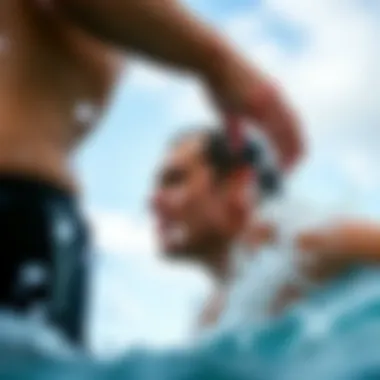
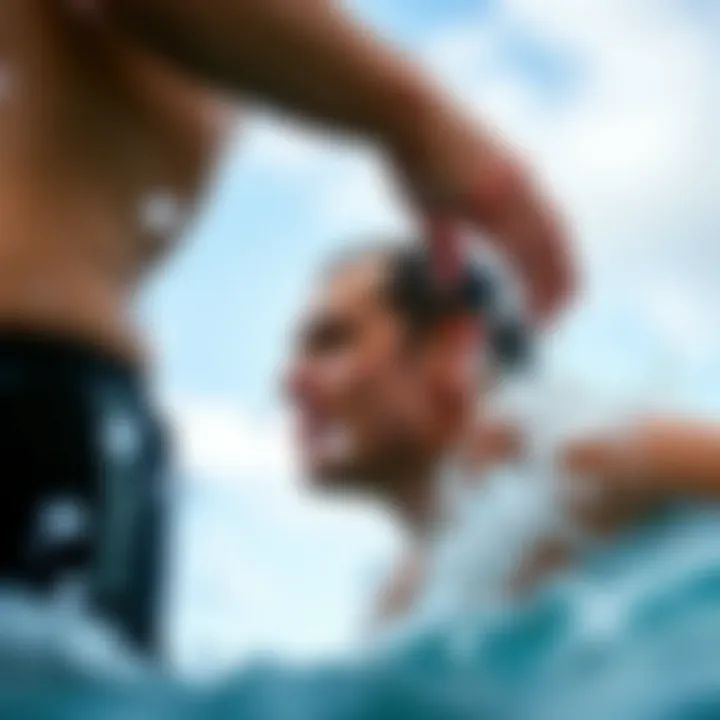
Inner Ear Functions
The inner ear is home to the cochlea, which is responsible for converting sound vibrations into nerve impulses that the brain interprets as sound. Additionally, the vestibular system helps with balance. If water occupies space in the inner ear, it can disrupt these functions, causing dizziness or temporary hearing loss. Keeping track of what happens there can be crucial, particularly during outdoor activities, as water entering this space may lead to further complications if not addressed promptly.
Overall, understanding ear anatomy grants insight into why water may become trapped and how various methods to remove it can be effective or ineffective depending on the situation. By familiarizing oneself with these structures, you can better appreciate the importance of taking proactive steps to manage ear health regardless of a situation that may arise.
Common Causes of Water-Trapped Ears
Understanding how and why water gets trapped in the ear is crucial for effectively addressing this common issue. Knowing the various scenarios in which this typically occurs can help individuals take proactive measures to vanquish discomfort before it even starts. There are several prevalent situations that lead to water finding its way into the ear canal; these situations can vary based on lifestyle, activities, and environmental factors. By being aware of these common causes, surfers, outdoor enthusiasts, and travel bloggers can make informed choices to prevent the aggravation of water-trapped ears, ensuring countless adventures remain enjoyable and pain-free.
Swimming
Swimming is one of the primary culprits when it comes to water entering the ear. Whether you're diving into the deep end or just splashing around in a pool, water can easily slip into the ear canal, causing that annoying feeling of fullness. The concern becomes even greater for those who frequent the ocean or lakes, where the warm sun can lure many surf lovers into the water.
When swimming, water can enter the ear through splashes or waves. Individuals who dive or are subjected to water pressure are especially prone to this issue. In fact, research suggests that swimmers, particularly those who engage in prolonged immersion, are more likely to experience trapped water. Depending on personal ear structure, some people might find themselves more susceptible to this problem than others.
Showering
Another common scenario where water ends up in the ears is during showering. Individuals often do not realize just how much water can accumulate while washing hair or quickly rinsing off. Hot showers, in particular, can create an ideal environment. The steam and heat can cause the ear canal to swell slightly, making it easier for water droplets to linger. Moreover, those who lean forward while washing their hair increase their chances of trapping water behind earlobes and ear drums.
Taking a few extra precautions, like keeping the head upright or using earplugs designed for shower use, can significantly reduce the likelihood of dealing with trapped water. Finding solutions that fit one's personal routine may go a long way toward maintaining ear health.
Excessive Humidity
Excessive humidity, often overlooked, can also play a role in water becoming trapped in the ear. High humidity levels can lead to condensation within the ear canal, particularly during hot outdoor excursions or in tropical climates. Individuals engaging in outdoor activities or traveling to humid regions should be especially mindful of these conditions. The moisture can create an uncomfortable feeling, similar to the sensation caused by swimming or showering, which may not necessarily dissipate.
Humidity creates a challenge because, unlike the direct exposure to water that occurs while swimming or showering, the ear canal may not feel wet immediately. However, after some time, this discomfort can escalate into what feels like liquid trapped inside. Understanding the impact of environmental factors allows individuals to prepare better and perhaps even avoid certain situations.
Remember, being aware of these common causes can empower individuals to take preemptive action and ultimately enjoy their activities without the nagging concern of water trapped in the ear.
Identifying Symptoms of Water in the Ear
Water trapped in the ear can often go unnoticed until it starts to cause noticeable discomfort. Recognizing the symptoms early can help in taking timely action. This section delves into the key signs that may indicate water is stuck in your ear, allowing you to be proactive about your ear health.
Feeling of Fullness
One of the first and most prevalent symptoms is a distinct feeling of fullness in the ear. It can be akin to the sensation you get when you ascend or descend in altitude, as if your eardrum is being pushed against or pulled away. This sensation might be slight at first but can escalate, becoming increasingly bothersome.
This feeling often results from pressure created by the trapped water, which can also interfere with your balance briefly. If you've just come from swimming or even taking a shower, pay attention. If that "plugged" sensation hangs around, it’s a clear sign that it's time to explore some removal methods.
Hearing Difficulties
Another telling symptom is a notable change in your hearing ability. You may notice sounds appearing muffled, almost like you're hearing them through a thick wall. This happens because the presence of water can obstruct the ear canal, creating an interference that distorts sound waves.
These hearing difficulties can be particularly alarming, especially for those who rely on auditory cues while participating in outdoor activities, like surfing or hiking in nature. The transient alteration may spark concern, prompting the need for effective methods to alleviate the blockage in the ear.
Discomfort or Pain
The presence of water can also lead to discomfort or outright pain in the ear. Initially, the discomfort may be mild but can morph into something more acute if the water remains trapped. The pressure and irritation from the liquid can put a strain on the delicate tissues within the ear, causing an annoying throbbing sensation.
While some discomfort is manageable, if the pain becomes sharp or persistent, it could be a signal of an underlying issue such as an ear infection. Thus, it’s crucial to monitor any accompanying symptoms and seek help if the distress continues.
Tip: If symptoms persist for more than a couple of days or worsen, consider consulting a medical professional for personalized advice and treatment.
For further reading and resources, you might find this helpful: American Academy of Otolaryngology or Mayo Clinic on Ear Health.
Again, keeping an eye on your symptoms can guide you towards effective solutions.
Initial Steps to Take
Experiencing water trapped in the ear can be not just annoying but also a bit nerve-wracking, especially if you’re in a hurry to dive back into the waves or continue your outdoor activities. Understanding the initial steps to take when faced with this common predicament is vital, as these actions can often resolve the issue before it escalates into something more serious. Taking prompt action not only alleviates discomfort but also prevents potential complications like infections. It’s essential to approach the situation calmly and systematically, employing simple techniques that can make a significant difference.
Stay Calm
When water gets stuck in your ear, the first piece of advice is simple yet crucial: stay calm. Panic can cloud your judgment and lead to rash decisions that might exacerbate the situation. Take a moment to breathe deeply and remind yourself that it’s a manageable issue. Staying cool-headed allows you to think clearly, which will help you remember and apply the techniques that can help remove the water effectively. As the saying goes, "Don’t make a mountain out of a molehill." It’s typically a straightforward fix, so keeping calm is step one.
Tilt Your Head
A common method to expel trapped water is to tilt your head towards the side of the affected ear. This may seem almost too simple, but gravity does have its way. By positioning your head, you allow the water to trickle down and out, rather than getting further lodged in the ear canal. You might want to help the process along with a gentle shake of your head. Some people find that hopping on one foot or gently hopping in place while in this position adds a bit of extra oomph. Just remember to do it gently, as you don’t want to create more stress for your eardrum.
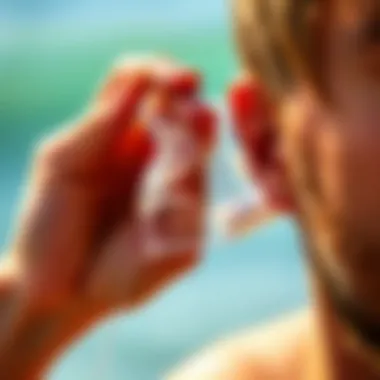
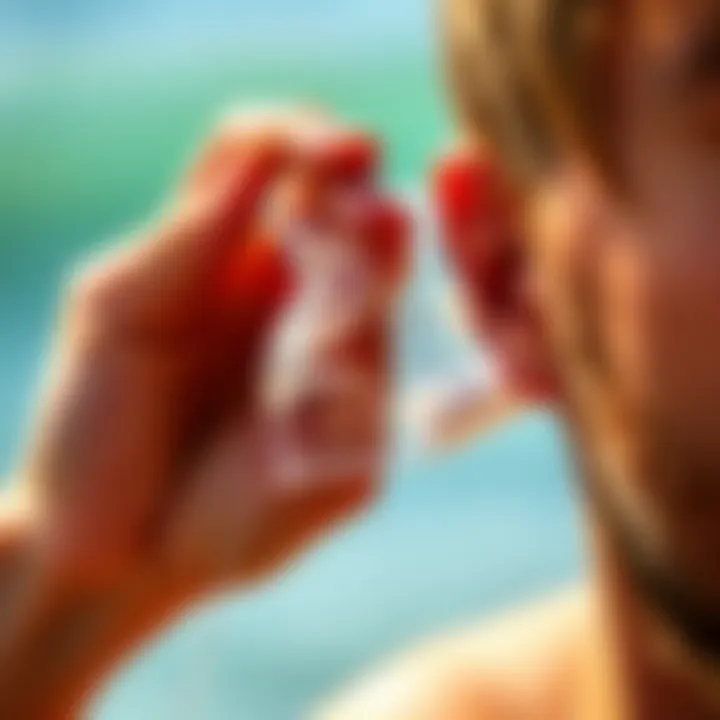
Chew or Yawn
Sometimes, the simplest methods can be the most effective. Chewing or yawning can help to equalize pressure in your ears, potentially dislodging the water in the process. When you chew or yawn, the muscles around your Eustachian tube activate, which can allow trapped fluid to escape. This technique is particularly useful if you’re feeling a bit of fullness in your ear. Many outdoor enthusiasts, perhaps after a long surf session or a day out in the wilderness, find this to be a surprisingly effective remedy. So next time you’re faced with this irritation, it might be worth giving your jaw a good workout.
It's important to remember that while these methods often offer relief, they may not always work instantly. If the discomfort persists, exploring other techniques or remedies will be necessary to ensure your ear health.
Physical Techniques for Removal
Dealing with water trapped in the ear can be frustrating, but physical techniques provide immediate relief options. Understanding these methods is crucial as they enable individuals to address the discomfort quickly and effectively without resorting to medical intervention unless absolutely necessary. The techniques discussed here not only offer instant aid but also diminish the risk of infections and other complications when performed properly. Effectively implementing these methods can be a game-changer for those who frequently swim or engage in other water activities. Here are several key methods to consider:
Gravity Method
The Gravity Method is often the first technique people think of, and for good reason. It relies on simply using the force of gravity to help draw out excess water from the ear canal. To perform this technique, one should tilt or bend the head toward the affected ear while pulling on the earlobe to straighten the ear canal. This simple maneuver allows gravity to do its job and encourages the water to flow out. It’s particularly effective because it requires no special tools or preparation, making it accessible for anyone, anywhere.
Vacuum Effect
Utilizing the Vacuum Effect can also be highly beneficial when attempting to free trapped water. This method creates a sealing pressure that helps to suction the water out. Here are two ways to effectively use this technique:
Creating a Seal with Your Hand
Creating a seal with your hand is a straightforward approach with a key characteristic—its effectiveness lies in how well you can form an airtight seal around your ear. This method involves placing your palm tightly against the ear with your head tilted, and then moving your palm away quickly to create suction. This enhances the likelihood of pulling the water out. This technique is popular not just for its simplicity; it can work wonders and usually requires little practice. However, it’s important to ensure that the ear is free from infection, as applying pressure during this maneuver can exacerbate existing problems. Remember to be mindful of your surroundings to avoid any distractions that might interrupt the process.
Using a Finger to Breathe
Another dimension of the Vacuum Effect is using a finger to breathe, which is as much about technique as about timing. The key here is to use one finger to close off the ear canal while simultaneously creating suction by taking a breath and releasing it in a controlled manner. This typically involves forming a tight seal with your finger and then letting go to allow air to flow back in. This method can be beneficial in varying circumstances and doesn't require any additional materials. It's a handy option to master, particularly for outdoor enthusiasts who might often end up with water in their ears while enjoying activities like surfing or swimming.
Jumping or Tilting
Once you've tried the Gravity Method and the Vacuum Effect, jumping or tilting can be considered as a follow-up technique. Sometimes a little bit of movement can jostle the water to come out. Jumping on one leg while keeping the affected ear facing downwards can provide just the right amount of movement to dislodge the water.
Ultimately, physical techniques for removal are quick and efficient ways to tackle the problem of water in the ear. The importance of knowing these methods cannot be overstated, as they empower individuals to take immediate action and potentially avoid more severe complications later on.
Alternative Home Remedies
Home remedies for removing water from the ear can be a simple yet effective approach. They often utilize common household items that are easily accessible and safe to use. These methods can provide relief without the need for invasive procedures, making them particularly appealing to those who are uncomfortable with medical interventions. While these remedies may not work for everyone, they are worth considering before a trip to the doctor.
Warm Compress
A warm compress is a straightforward technique that helps ease discomfort and promote drainage. By applying heat, you can help stimulate blood flow in the area, encouraging the water to move out of the ear canal more effectively. The warmth can also provide a certain sense of comfort and relaxation.
To use this method:
- Take a clean washcloth and soak it in warm water.
- Wring it out so that it's damp, but not dripping.
- Hold the cloth against the affected ear for about 5-10 minutes.
This method can be especially beneficial if you have that annoying full feeling in your ear, and it may help in softening earwax, which could be contributing to the sensation of water being trapped.
Olive Oil or Glycerin
Both olive oil and glycerin are common home remedies when it comes to ear problems. They are gentle, soothing, and can help ease water out of the ear. The oil acts by coating the ear canal, which helps to soften the wax and potentially encourage the movement of trapped water.
Here’s how to use it:
- Warm a few drops of olive oil slightly in the palm of your hand, but ensure it's not too hot.
- Using a dropper, place two to three drops into the affected ear.
- Wait a few minutes, and then tilt your head to the opposite side, allowing the excess oil (along with any trapped water) to drain out.
Glycerin works similarly. It has a slightly different texture and may help in creating a slight suction that aids in drawing out water from the ear. Either way, both are worth having in your home remedy arsenal for ear woes.
Hydrogen Peroxide Solution
Hydrogen peroxide is often used for cleaning and disinfecting, but it also has its place in ear care. It can help with flushing out water from the ear canal and can also fight off any potential bacteria that may have made their way in. However, it’s crucial to use it in a diluted form to avoid any irritation.
To prepare and use:
- Mix equal parts of hydrogen peroxide and water (typically a 3% solution is safe).
- Using a dropper, place a few drops into the ear.
- Allow it to sit for a few minutes; you'll likely hear a fizzing sound as it works.
- Finally, tilt your head to let it drain out, and wipe any excess fluid with a clean cloth.
While effective, it’s important to make sure your eardrum is intact before trying this method. If there are any signs of infection or significant pain, it’s best to consult with a healthcare professional.
Remember, while these remedies can provide relief for many, they may not be universal solutions for everyone. Listening to your body and knowing when to seek help is just as important as attempting these home solutions.


Preventing Water from Entering the Ear
Water trapped in the ear can be an irritating and sometimes painful experience. To avoid this troublesome situation, taking preventive measures is essential, especially for those frequently exposed to water, like swimmers, surfers, and beachgoers. Understanding the importance of prevention not only alleviates discomfort but also helps to avert infections that might arise from stagnant water.
By being proactive, individuals can enjoy their time in water activities without the constant worry of water getting stuck within their ears. Simple yet effective strategies can be easily integrated into routine practices, resulting in a more enjoyable and safer experience overall. Below, we explore specific elements and considerations about preventing water from entering the ear.
Using Earplugs
Earplugs are a simple yet effective device for those who spend a lot of time in water. They act as a barrier, preventing water from entering the ear canal, which is particularly helpful during swimming or diving. Look for waterproof earplugs designed specifically for these activities; they are generally made from silicone or foam and can create a snug fit that keeps water out.
- Comfort Fit: Make sure the earplugs you choose are comfortable and fit well. Some are even available in custom sizes.
- Reusable Options: Consider reusable earplugs that provide a long-term solution, especially if you are a frequent swimmer.
Using earplugs not only keeps water at bay but also helps in minimizing sound exposure, which can be beneficial in crowded and noisy environments.
Avoiding Submersion
Another straightforward strategy is simply avoiding submersion whenever possible. This applies particularly during swimming sessions. If you’re surfing or partaking in other water activities, try to stay in shallower waters where you can maintain your head above the surf. It’s about being mindful of your surroundings.
- Know Your Limits: If you understand your comfort level in water, you can make better choices in where to swim or surf.
- Alternative Activities: Try activities where you remain relatively dry, such as paddleboarding.
Being mindful of depth and avoiding submersion can significantly reduce your chances of water entering your ears, making your aquatic experience much more pleasant.
Drying Techniques Post-Activity
After an active day in the water, employing certain drying techniques can facilitate the removal of residual moisture from your ears. These methods don't just stop water from lingering but help keep the ear canal dry, lowering the risk of infections.
- Tilting Your Head: After swimming, tilt your head to one side to let gravity assist in draining any trapped water.
- Using a Towel: Gently drying the outer ear with a towel can also help to remove excess moisture.
- Blow-Drying on Low: Using a hair dryer on the lowest setting can aid in evaporation but maintain a safe distance to avoid injury.
"Prevention is better than cure," as the old saying goes. Incorporating these techniques as routine practices can spare you discomfort and the hassle of dealing with trapped water in your ears.
When to Seek Medical Attention
Knowing when to seek medical help is crucial when water gets trapped in your ear. Often, people assume it’s just a minor annoyance that will resolve on its own, but there are certain situations where a trip to the doctor becomes necessary. Ignoring the signs can lead to complications, making it vital to understand when to pick up the phone.
Signs of Infection
One of the key indicators that professional help is needed is the appearance of infection signs. If you find yourself feeling unusually unwell, and your ear starts to throb or emit a foul odor, it’s time to get proactive. Some common infection symptoms include:
- Redness or swelling around the ear: When the skin looks inflamed, that's a red flag.
- Discharge: If you notice fluid leaking from your ear that is not just water – particularly if it's colored or has a bad smell – it points to an infection.
- Fever: A rising temperature can indicate your body is fighting off an infection.
It is essential to address these symptoms swiftly. Your doctor might prescribe antibiotics or recommend other treatments to combat the infection and prevent it from escalating.
Persistent Discomfort
If the discomfort lingers longer than expected, it might be a cause for concern. While a little discomfort is somewhat normal after getting water in your ear, constant pain that doesn't fade can suggest a deeper issue. A couple of points to ponder include:
- Duration: Generally, if discomfort lasts over 48 hours, it’s wise to seek a professional opinion.
- Worsening Pain: If your pain has increased or has gone from mild to severe, don’t hesitate to consult with a healthcare provider. Persistent pain could mean an underlying condition, such as a perforated eardrum, which needs medical intervention.
Hearing Loss Concerns
Having difficulty hearing after experiencing water in your ear should not be taken lightly. If your hearing doesn’t return soon after the situation has been addressed or if it worsens over time, it’s a strong indication that you should consult a specialist. Consider the following:
- Sudden Hearing Loss: If you notice a sharp decrease in your hearing ability, visit a professional immediately.
- Accompanying Symptoms: If hearing loss is coupled with vertigo, tinnitus (ringing in the ears), or balance problems, these could be signs of more serious conditions requiring immediate care.
Keeping your ears healthy is paramount, especially for surfers, outdoor enthusiasts, or any active individuals. By recognizing these warning signs and not brushing them off, you can prevent potential complications and ensure your ear health remains in top shape.
Epilogue
Dealing with water trapped in the ear can be an unsettling experience. It's not just about the undeniable discomfort; prolonged water retention can lead to infections and other complications if not managed appropriately. This article encapsulates crucial strategies to effectively address this common issue, offering readers practical steps to follow in various situations, ensuring a sense of relief and maintaining good ear health.
Summarizing Key Points
To summarize the key points discussed:
- Understanding Ear Anatomy: Grasping how the outer, middle, and inner ear work helps to clarify why water gets trapped and why it matters to manage it.
- Common Causes: Identifying the usual suspects, like swimming and showering, reminds us that these activities are not just enjoyment; they require attention to ear health.
- Symptoms: Recognizing symptoms such as fullness, hearing difficulties, and discomfort can prompt timely action.
- Initial Steps: Simple actions like staying calm and tilting one’s head can kickstart the removal process effectively.
- Physical Techniques: Methods using gravity or vacuum effects can be practical go-to's in removing water.
- Home Remedies: Options like warm compresses or various liquids can offer gentle solutions when traditional methods fall short.
- Preventive Measures: Using earplugs or drying techniques post-activity are smart ways to avoid future issues.
- When to Seek Medical Attention: Knowing when discomfort is signaling a bigger problem is vital for maintaining ear health.
Final Recommendations
In light of all this information, here are some final recommendations:
- Stay Proactive: Don’t wait until discomfort escalates. If water remains in your ear after trying initial removal techniques, consider next steps promptly.
- Prioritize Prevention: Invest in good-quality earplugs, especially if you're often in the water. Preventing entry is far easier than dealing with the repercussions later.
- Listen to Your Body: If you notice persistent pain, discomfort, or changes in your hearing, reaching out to a healthcare professional shouldn't be delayed.
- Stay Informed: Regularly educate yourself about ear health by referring to reliable sources such as CDC and WebMD.
Taking care of your ears isn’t just about comfort. It’s about protecting one's overall well-being, particularly for surfers, outdoor enthusiasts, and travelers who find themselves in challenging water conditions. Understanding the dynamics of water in the ear equips you with the tools needed to tackle the issue head-on.







